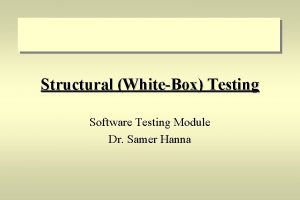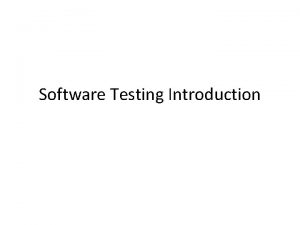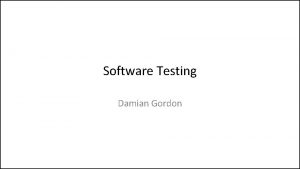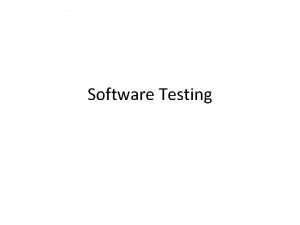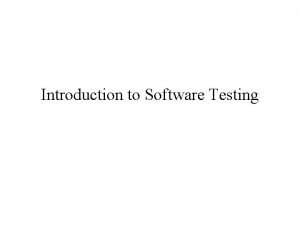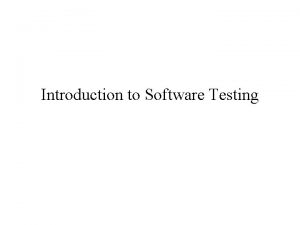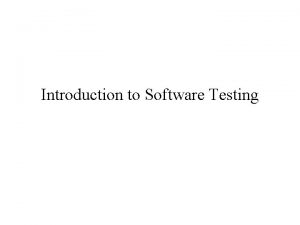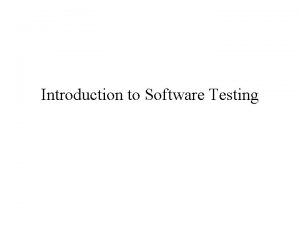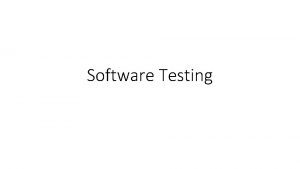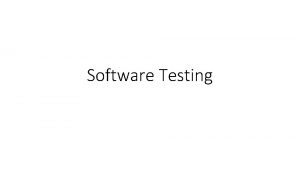Introduction to Software Testing Chapter 2 3 Graph








![Example Control Flow – Stats public static void compute. Stats (int [ ] numbers) Example Control Flow – Stats public static void compute. Stats (int [ ] numbers)](https://slidetodoc.com/presentation_image/10d80de1c03350e6e4ce6de92fe6ee30/image-9.jpg)
![Control Flow Graph for Stats public static void compute. Stats (int [ ] numbers) Control Flow Graph for Stats public static void compute. Stats (int [ ] numbers)](https://slidetodoc.com/presentation_image/10d80de1c03350e6e4ce6de92fe6ee30/image-10.jpg)




![Test Cases and Test Paths Test Case : numbers = [2, 10, 15] ; Test Cases and Test Paths Test Case : numbers = [2, 10, 15] ;](https://slidetodoc.com/presentation_image/10d80de1c03350e6e4ce6de92fe6ee30/image-15.jpg)
- Slides: 15

Introduction to Software Testing Chapter 2. 3 Graph Coverage for Source Code Paul Ammann & Jeff Offutt

Overview n n n The most common application of graph criteria is to program source Graph : Usually the control flow graph (CFG) Node coverage : Execute every statement Edge coverage : Execute every branch Loops : Looping structures such as for loops, while loops, etc. Data flow coverage : Augment the CFG n n defs are statements that assign values to variables uses are statements that use variables

Control Flow Graphs n n n A CFG models all executions of a method by describing control structures Nodes : Statements or sequences of statements (basic blocks) Edges : Transfers of control Basic Block : A sequence of statements such that if the first statement is executed, all statements will be (no branches) CFGs are sometimes annotated with extra information n n branch predicates defs uses Rules for translating statements into graphs …

CFG : The if Statement if (x < y) { y = 0; x = x + 1; } else { x = y; } 1 x<y y=0 x=x+1 x >= y 2 3 x=y 4 if (x < y) { y = 0; x = x + 1; } 1 x<y y=0 x=x+1 2 x >= y 3

CFG : The if-Return Statement if (x < y) { return; } print (x); return; 1 x<y return 2 x >= y 3 No edge from node 2 to 3. The return nodes must be distinct. print (x) return

Loops n Loops require “extra” nodes to be added n Nodes that do not represent statements or basic blocks

CFG : while and for Loops x = 0; while (x < y) { y = f (x, y); x = x + 1; } x=0 1 dummy node 2 x<y x >= y 3 4 implicitly initializes loop x=0 y =f(x, y) x=x+1 1 2 for (x = 0; x < y; x++) { y = f (x, y); } y = f (x, y) implicitly increments loop x<y x >= y 3 5 4 x=x+1

CFG : The case (switch) Structure read ( c) ; switch ( c ) { case ‘N’: y = 25; break; case ‘Y’: y = 50; break; default: y = 0; break; } print (y); read ( c ); 1 c == ‘N’ y = 25; break; 2 c == ‘Y’ default 3 4 y = 50; break; 5 print (y); y = 0; break;
![Example Control Flow Stats public static void compute Stats int numbers Example Control Flow – Stats public static void compute. Stats (int [ ] numbers)](https://slidetodoc.com/presentation_image/10d80de1c03350e6e4ce6de92fe6ee30/image-9.jpg)
Example Control Flow – Stats public static void compute. Stats (int [ ] numbers) { int length = numbers. length; double med, var, sd, mean, sum, varsum; sum = 0; for (int i = 0; i < length; i++) { sum += numbers [ i ]; } med = numbers [ length / 2 ]; mean = sum / (double) length; varsum = 0; for (int i = 0; i < length; i++) { varsum = varsum + ((numbers [ I ] - mean) * (numbers [ I ] - mean)); } var = varsum / ( length - 1. 0 ); sd = Math. sqrt ( var ); } System. out. println ("length: " + length); System. out. println ("mean: " + mean); System. out. println ("median: " + med); System. out. println ("variance: " + var); System. out. println ("standard deviation: " + sd);
![Control Flow Graph for Stats public static void compute Stats int numbers Control Flow Graph for Stats public static void compute. Stats (int [ ] numbers)](https://slidetodoc.com/presentation_image/10d80de1c03350e6e4ce6de92fe6ee30/image-10.jpg)
Control Flow Graph for Stats public static void compute. Stats (int [ ] numbers) { int length = numbers. length; double med, var, sd, mean, sum, varsum; sum = 0; for (int i = 0; i < length; i++) { sum += numbers [ i ]; } med = numbers [ length / 2 ]; mean = sum / (double) length; 1 2 3 i=0 i >= length varsum = 0; i < length for (int i = 0; i < length; i++) i++ 4 { varsum = varsum + ((numbers [ I ] - mean) * (numbers [ I ] - mean)); } var = varsum / ( length - 1. 0 ); sd = Math. sqrt ( var ); } System. out. println ("length: " + length); System. out. println ("mean: " + mean); System. out. println ("median: " + med); System. out. println ("variance: " + var); System. out. println ("standard deviation: " + sd); 5 i=0 6 i < length i >= length 7 8 i++

Control Flow Graph for Stats 1 ( numbers ) sum = 0 length = numbers. length 2 i=0 3 i >= length i < length 4 5 sum += numbers [ i ] i++ mean = sum / (double) length; med = numbers [ length / 2 ] varsum = 0 i=0 6 i >= length i < length varsum = … i++ 7 8 var = varsum / ( length - 1. 0 ) sd = Math. sqrt ( var ) print (length, mean, med, var, sd)

Control Flow TRs and Test Paths – EC 1 Edge Coverage 2 Test Path TR A. [ 1, 2 ] [ 1, 2, 3, 4, 3, 5, 6, 7, 6, 8 ] B. [ 2, 3 ] C. [ 3, 4 ] D. [ 3, 5 ] E. [ 4, 3 ] F. [ 5, 6 ] G. [ 6, 7 ] H. [ 6, 8 ] I. [ 7, 6 ] 3 4 5 6 7 8

Control Flow TRs and Test Paths – EPC 1 Edge-Pair Coverage 2 3 4 5 6 7 8 TR A. [ 1, 2, 3 ] B. [ 2, 3, 4 ] C. [ 2, 3, 5 ] D. [ 3, 4, 3 ] E. [ 3, 5, 6 ] F. [ 4, 3, 5 ] G. [ 5, 6, 7 ] H. [ 5, 6, 8 ] I. [ 6, 7, 6 ] J. [ 7, 6, 8 ] K. [ 4, 3, 4 ] L. [ 7, 6, 7 ] Test Paths i. [ 1, 2, 3, 4, 3, 5, 6, 7, 6, 8 ] ii. [ 1, 2, 3, 5, 6, 8 ] iii. [ 1, 2, 3, 4, 3, 5, 6, 7, 6, 8 ] TP TRs toured sidetrips i A, B, D, E, F, G, I, J C, H ii A, C, E, H iii A, B, D, E, F, G, I, J, K, L C, H

Control Flow TRs and Test Paths – PPC Prime Path Coverage 1 2 3 4 5 6 7 TR A. [ 3, 4, 3 ] B. [ 4, 3, 4 ] C. [ 7, 6, 7 ] D. [ 7, 6, 8 ] E. [ 6, 7, 6 ] F. [ 1, 2, 3, 4 ] G. [ 4, 3, 5, 6, 7 ] H. [ 4, 3, 5, 6, 8 ] I. [ 1, 2, 3, 5, 6, 7 ] J. [ 1, 2, 3, 5, 6, 8 ] 8 Test Paths i. [ 1, 2, 3, 4, 3, 5, 6, 7, 6, 8 ] ii. [ 1, 2, 3, 4, 3, 5, 6, 7, 6, 8 ] Infeasible iii. [ 1, 2, 3, 4, 3, 5, 6, 8 ]test path iv. [ 1, 2, 3, 5, 6, 7, 6, 8 ]Infeasible test path v. [ 1, 2, 3, 5, 6, 8 ] TP TRs toured sidetrips i A, D, E, F, G H, I, J ii A, B, C, D, E, F, G, H, I, J iii A, F, H J iv D, E, F, I J v J
![Test Cases and Test Paths Test Case numbers 2 10 15 Test Cases and Test Paths Test Case : numbers = [2, 10, 15] ;](https://slidetodoc.com/presentation_image/10d80de1c03350e6e4ce6de92fe6ee30/image-15.jpg)
Test Cases and Test Paths Test Case : numbers = [2, 10, 15] ; length = 3 Test Path : [ 1, 2, 3, 4, 3, 5, 6, 7, 6, 8 ] - 100% node and edge coverage achieved - More than one loop iteration Test Case : numbers = [44] ; length = 1 Test Path : [ 1, 2, 3, 4, 3, 5, 6, 7, 6, 8 ] - 100% node and edge coverage achieved - Exactly one loop iteration Test Case : numbers = [] ; length = 0 Test Path : [ 1, 2, 3, 5, 6, 8 ] But the method fails with divide by zero on the statement … mean = sum / (double) length; - 75% (=6/8) node and 41. 7 % = (5/12) edge coverage achieved - 0 loop iteration A bug found
 What is domain testing
What is domain testing Logic based testing in software testing
Logic based testing in software testing Du path testing
Du path testing What is globalization testing
What is globalization testing Language testing
Language testing Control structure testing in software engineering
Control structure testing in software engineering Decision table testing in software testing
Decision table testing in software testing Decision table testing examples
Decision table testing examples Decision tables testing
Decision tables testing Rigorous testing in software testing
Rigorous testing in software testing Testing blindness in software testing
Testing blindness in software testing Software domain examples
Software domain examples State state graphs and transition testing
State state graphs and transition testing Dd path in software testing
Dd path in software testing Edge coverage in software testing
Edge coverage in software testing Good state graphs and bad state graphs in software testing
Good state graphs and bad state graphs in software testing













